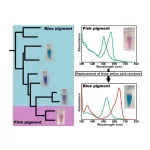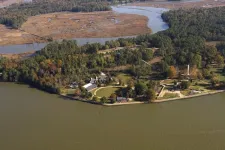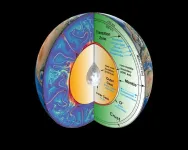Novel photoreceptor sheds light on how cyanobacteria see color
Scientists highlight diversity and editability in photosensitive molecules
2024-08-17
(Press-News.org)
Tokyo, Japan – Scientists from Tokyo Metropolitan University have identified a new photoreceptor in cyanobacteria with a modification in part of its structure which makes it sensitive to green/teal light. The photoreceptor belongs in a family usually sensitive to red/green light in the environment. They identified the parts of its amino acid structure responsible for this behavior; editing them helped restore sensitivity to red and green light, a remarkable example of molecular “plasticity” in action.
Cyanobacteria, also known as blue-green algae, are phenomenally important players in shaping the natural world as we know it. They are the first organisms on Earth known to have produced oxygen, using light to break down water molecules. The same chemical process is a distant relative of the photosynthesis seen in plants. The chemical apparatus that helps such processes in cyanobacteria are known as cyanobacteriochromes (CBCRs), cyanobacteria-specific photoreceptors; these are amino acid-based constructs which make them sensitive not only to the amount, but the color of light in the surroundings, helping them acclimate to convert energy as efficiently as possible.
But how exactly do cyanobacteria tell apart color? In the case of CBCRs, they bind a chemical containing a chemical group known as a linear tetrapyrrole. There is a vast range of linear tetrapyrrole pigments, with a color response determined by the length of the cloud of “conjugated” electrons running along. For example, phycocyanobilin (PCB), a blue pigment, will be bound by a CBCR and help it respond to red or green light, switching reversibly between two different absorbing states depending on the ratio of red and green light in the environment. On the other hand, CBCR binding phycoviolobilin (PVB), a pink pigment, will respond to violet or yellow light in a similar way. Interestingly, PCB and PVB are an “isomer” pair, in that they share the same chemical composition, but with double bonds at different positions, drastically switching its color. The way in which pigments bind to CBCRs is remarkably sensitive to its specific structure, as determined by its amino acid sequence, but the ways in which different pigment/CBCR pairs give rise to a whole myriad of responses to light is not yet fully understood.
Now, a team of researchers led by Associate Professor Rei Narikawa from Tokyo Metropolitan University have uncovered another piece of the puzzle, discovering a new CBCR from the family of photoreceptors which should be sensitive to red and green light. Uniquely, this CBCR binds PVB, the pink pigment, and responds to green or teal light. Given the differences with normal PVB binding CBCRs, the team concluded that the pigment was bound to the CBCR in a new, different way. By analyzing the structure carefully, they also identified three key amino acid residues which they determined to be key to this unusual response. Having modified them, the newly edited CBCR could induce the PVB to become PCB again (the blue pigment), restoring sensitivity to red and green light.
The work highlights the remarkable diversity and “plasticity” of CBCRs, the ability to be molded or changed, expanding our understanding of how cyanobacteria can “see” the world in color.
This work was supported by JSPS KAKENHI Grant Number JP22H02587425 and the TMU Research Fund for Young Scientists from Tokyo Metropolitan University.
END
[Attachments] See images for this press release:

ELSE PRESS RELEASES FROM THIS DATE:
2024-08-17
Researchers led by Cranfield University have developed new ways to detect sugar syrup adulteration in honey, paving the way for fast and accurate tests to discover fake products.
There is growing consumer demand for honey, with £89.8 million worth of honey imported to the UK in 2023. But as a high-value product it is vulnerable to fraud, with syrups added to dilute the pure honey – a report from the European Commission in 2023 found 46% of 147 honey samples tested were likely to have been adulterated with cheap plant syrups.
Because honey’s characteristics vary due to sources of nectar, season of harvest and ...
2024-08-17
Sustainably reducing inappropriate IV use by more than a third
Reasearch led by Amsterdam UMC, across more than 5 years and 1100 patients has demonstrated a strategy for reducing inappropriate IV use by a third, an effect that was sustained across the five-year period. This should also lead to reduction in the associated infections that effect one in ten patients. These results are published today in The Lancet eClinicalMedicine.
"Infections caused by both IVs and catheters occur in more than 10% of patients and studies indicate that up to a quarter are not necessary. Simply, this means that patients are placed at ...
2024-08-16
Two University of Alaska Fairbanks scientists have discovered a new type of “whistler,” an electromagnetic wave that carries a substantial amount of lightning energy to the Earth’s magnetosphere.
The research is published today in Science Advances.
Vikas Sonwalkar, a professor emeritus, and Amani Reddy, an assistant professor, discovered the new type of wave. The wave carries lightning energy, which enters the ionosphere at low latitudes, to the magnetosphere. The energy is reflected upward by the ionosphere’s ...
2024-08-16
A fish on land still waves its fins, but the results are markedly different when that fish is in water. Attributed to renowned computer scientist Alan Kay, the analogy is used to illustrate the power of context in illuminating questions under investigation.
In a first for the field of artificial intelligence (AI), a tool called PINNACLE embodies Kay’s insight when it comes to understanding the behavior of proteins in their proper context as determined by the tissues and cells in which these proteins act and ...
2024-08-16
In response to the COVID-19 pandemic, a majority of schools across the U.S. shifted to virtual learning. In a new study, published in Social Education Research, researchers conducted interviews with parents of students who attended middle or high schools to understand how virtual learning impacted their daily routines, stress levels, and the academic performance of the children.
The transition to virtual learning necessitated the creation of online lessons in a very short time period and with limited training of teachers. As a result, parents and students had to deal with unexpected changes in their home lives and learning environments.
“Virtual learning will not be limited ...
2024-08-16
Previous scientific studies have indicated that North American dog lineages were replaced with European ones between 1492 and the present day. To better understand the timing of this replacement, researchers from the University of Illinois Urbana-Champaign and the University of Iowa sequenced mitochondrial DNA from archaeological dogs. Their findings suggest a complex social history of dogs during the early colonial period.
Europeans and Native Americans valued their dogs as companion animals, using them for similar work and as symbols of identity. Consequently, ...
2024-08-16
A team led by Jose Onuchic at Rice University and Paul Whitford at Northeastern University, both researchers at the National Science Foundation Physics Frontiers Center at the Center for Theoretical Biological Physics (CTBP) at Rice, has made a discovery in the fight against severe acute respiratory syndrome coronavirus-2 (SARS-CoV-2), the virus responsible for COVID-19.
The team, in partnership with an experimental effort led by Yale University researchers Walter Mothes and Wenwei Li, has uncovered new insights into how the virus infects human cells and how it can be neutralized. Their findings were published in the ...
2024-08-16
AURORA, Colo. (August 16, 2024) – A new study, out now in Drug and Alcohol Dependence, that details trends among psychiatric hospitalizations between 2015-2019 finds that while most hospitalizations did not involve any substances, methamphetamine-related hospitalizations have increased while overall number of psychiatric hospitalizations remained stable.
Additionally, researchers detail that psychiatric hospitalizations caused by methamphetamine use were highest in the Mountain West region but were also shifting geographically. “Rates of ...
2024-08-16
In an innovative ecological article, researchers have unveiled the potential of phytoremediation to curb microplastic pollution. This approach leverages natural plant processes to absorb and diminish micro and nanoplastics, offering a viable solution for managing environmental plastic pollution. This viewpoint advocates utilizing plant life as an effective tool against the widespread issue of plastic contamination in ecosystems.
With escalating concerns about the enduring impact of plastic waste, phytoremediation emerges as a promising solution. This method utilizes plants ...
2024-08-16
For the decades since their discovery, seismic signals known as PKP precursors have challenged scientists. Regions of Earth’s lower mantle scatter incoming seismic waves, which return to the surface as PKP waves at differing speeds.
The origin the precursor signals, which arrive ahead of the main seismic waves that travel through Earth’s core, has remained unclear, but research led by University of Utah geophysicists sheds new light on this mysterious seismic energy.
PKP precursors appear to propagate from places deep below North America and the western Pacific and possibly bear an association with “ultra-low velocity zones,” thin layers ...
LAST 30 PRESS RELEASES:
[Press-News.org] Novel photoreceptor sheds light on how cyanobacteria see color
Scientists highlight diversity and editability in photosensitive molecules






